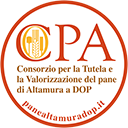Durum wheat is the first basic element in making good bread, sourdough is the second, and the oven is the third: traditional stone ovens are still an important urban element in Altamura. They can be built of tufa or “màzzaro” (Gravina stone), a local refractory marble; they have very high hoods, mouths capable of holding even more than 300 kilograms of bread (in the old days, they used to make bakes of even 550 kilograms), and the baking shovels necessarily have very long handles. These are direct-fired wood-fired ovens traditionally fueled only with oak wood. Historically, ovens were neighborhood or masseria: each neighborhood had one, and of course each masseria had to be self-sufficient in everything.
The bakery did not exist; it was the direct result of the work of the transporting baker (u carreisceapèi’n_the bread transporter) who would go out through the neighborhood with a long wooden plank and pick up the housewives’ kneaded forms to take to the oven. Two to six firings a day were done depending on the temperature of the outside environment, which affects the temperature inside the oven; with the housewives, schedules were scheduled “first oven (around 5 a.m.), second oven (around 8 a.m.)…” The baker was then paid in kind, usually with a piece of raw dough of about 300 grams (u c’cìj now called ciccio).
U carreisceapèi’n is an identity symbol of the city of Altamura. Luigi Picerno of PanBiscò has been guarding a dream for a long time: a monument dedicated to Pane di Altamura DOP and its bakers to be placed in a strategic spot, and given to the city. The statue is a reminder of his childhood, the baker “Colino” Nicola Pignatelli, who used to bring bread to homes in Altamura.

















